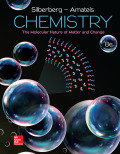
Concept explainers
(a)
Interpretation:
The mass
Concept introduction:
Molar mass is defined as the mass of
(a)
Answer to Problem 3.19P
The mass
Explanation of Solution
The formula to calculate the molar mass of
Substitute
The expression to calculate the mass
Substitute
The mass
(b)
Interpretation:
The mass
Concept introduction:
One mole is defined as the amount of substance that contains the same number of entities such as molecules, ions, atoms as the number of atoms in
Molar mass is defined as the mass of
Following are the steps to calculate the mass of a chemical substance when a number of molecules are given.
Step 1: Determine the amount of substance in moles by using Avogadro’s number. The expression to calculate the moles of a chemical substance is as follows:
Step 2: Multiply the moles with the molar mass of the chemical substance to obtain the mass of chemical substance in grams. The formula to calculate the mass of a substance in grams is as follows:
(b)
Answer to Problem 3.19P
The mass
Explanation of Solution
Dichlorine heptoxide is an inorganic compound with the chemical formula
The formula to calculate the molar mass of
Substitute
The expression to calculate moles of
Substitute
The expression to calculate the mass
Substitute
The mass
(c)
Interpretation:
The number of moles and formula units in
Concept introduction:
One mole is defined as the amount of substance that contains the same number of entities such as molecules, ions, atoms as the number of atoms in
Molar mass is defined as the mass of
A formula unit is used for the ionic compound to represent their empirical formula. The steps to determine the formula unit of an ionic compound from the given mass are as follows:
Step 1: Divide the given mass of the ionic compound with the molar mass to calculate the moles. The expression to calculate the moles of an ionic compound when the mass is given is as follows:
Step 2: Multiply the calculated moles with the Avogadro’s number to determine the formula units of an ionic compound. The expression to determine the formula unit is as follows:
(c)
Answer to Problem 3.19P
The number of moles and formula unit in
Explanation of Solution
Lithium sulfate is an ionic compound with the chemical formula
The formula to calculate the molar mass of
Substitute
The expression to calculate moles of
Substitute
The expression to calculate formula units (FU) of
Substitute
The number of moles and formula unit in
(d)
Interpretation:
The number of lithium ions, sulfate ions, sulfur atoms and oxygen atoms in the mass of the compound
Concept introduction:
A formula unit is used for the ionic compound to represent their empirical formula. The molecular formula of a compound tells the number of atoms/ions of each element present in the compound.
A number of ions in a chemical compound is directly linked to the formula unit of the compound.
(d)
Answer to Problem 3.19P
The number of lithium ions is
Explanation of Solution
The expression to calculate the number of ions/atoms in
Substitute
Substitute
Substitute
Substitute
The number of lithium ions is
Want to see more full solutions like this?
Chapter 3 Solutions
EBK CHEMISTRY: THE MOLECULAR NATURE OF
 ChemistryChemistryISBN:9781305957404Author:Steven S. Zumdahl, Susan A. Zumdahl, Donald J. DeCostePublisher:Cengage Learning
ChemistryChemistryISBN:9781305957404Author:Steven S. Zumdahl, Susan A. Zumdahl, Donald J. DeCostePublisher:Cengage Learning ChemistryChemistryISBN:9781259911156Author:Raymond Chang Dr., Jason Overby ProfessorPublisher:McGraw-Hill Education
ChemistryChemistryISBN:9781259911156Author:Raymond Chang Dr., Jason Overby ProfessorPublisher:McGraw-Hill Education Principles of Instrumental AnalysisChemistryISBN:9781305577213Author:Douglas A. Skoog, F. James Holler, Stanley R. CrouchPublisher:Cengage Learning
Principles of Instrumental AnalysisChemistryISBN:9781305577213Author:Douglas A. Skoog, F. James Holler, Stanley R. CrouchPublisher:Cengage Learning Organic ChemistryChemistryISBN:9780078021558Author:Janice Gorzynski Smith Dr.Publisher:McGraw-Hill Education
Organic ChemistryChemistryISBN:9780078021558Author:Janice Gorzynski Smith Dr.Publisher:McGraw-Hill Education Chemistry: Principles and ReactionsChemistryISBN:9781305079373Author:William L. Masterton, Cecile N. HurleyPublisher:Cengage Learning
Chemistry: Principles and ReactionsChemistryISBN:9781305079373Author:William L. Masterton, Cecile N. HurleyPublisher:Cengage Learning Elementary Principles of Chemical Processes, Bind...ChemistryISBN:9781118431221Author:Richard M. Felder, Ronald W. Rousseau, Lisa G. BullardPublisher:WILEY
Elementary Principles of Chemical Processes, Bind...ChemistryISBN:9781118431221Author:Richard M. Felder, Ronald W. Rousseau, Lisa G. BullardPublisher:WILEY





